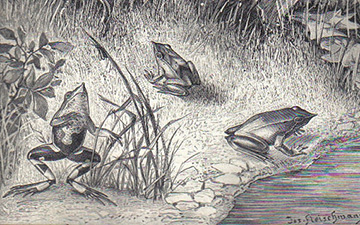The Chile Darwin’s frog (Rhinoderma rufum) is one of only two members of the family Rhinodermatidae. It is endemicto Chile.
This species of frog exhibits a highly unusual form of parental care in that the tadpoles spend part of their life developing in the vocal sac of their father, where they are transferred to a pool of water in their father’s vocal sac where they complete their development from the tadpole to the frog form.
Very little is known about this species, but its natural habitats are probably temperate forests, rivers and swamps. It is currently considered critically endangered, but as there have been no confirmed records since around 1980, it may already be extinct.[2] If still extant, it is likely to be threatened by habitat loss and pollution.
Recently seen in the coastal ranges near Cholguaco river, January 2013.
On January 21, 2008, Evolutionarily Distinct and Globally Endangered (EDGE), per chief Helen Meredith identified nature’s most weird, wonderful and endangered species: “The EDGE amphibians are amongst the most remarkable and unusual species on the planet and yet an alarming 85% of the top 100 are receiving little or no conservation attention.” The top 10 endangered species (in the List of endangered animal species include: the Chinese giant salamander, a distant relative of the newt, the tiny Gardiner’s Seychelles, the limbless Sagalla caecilian, South African ghost frogs, lungless Mexican salamanders, the Malagasy rainbow frog, Chile’s Darwin frog (Rhinoderma rufum) and the Betic midwife toad.[3][4][5]
(Wikipedia, October 2013)



